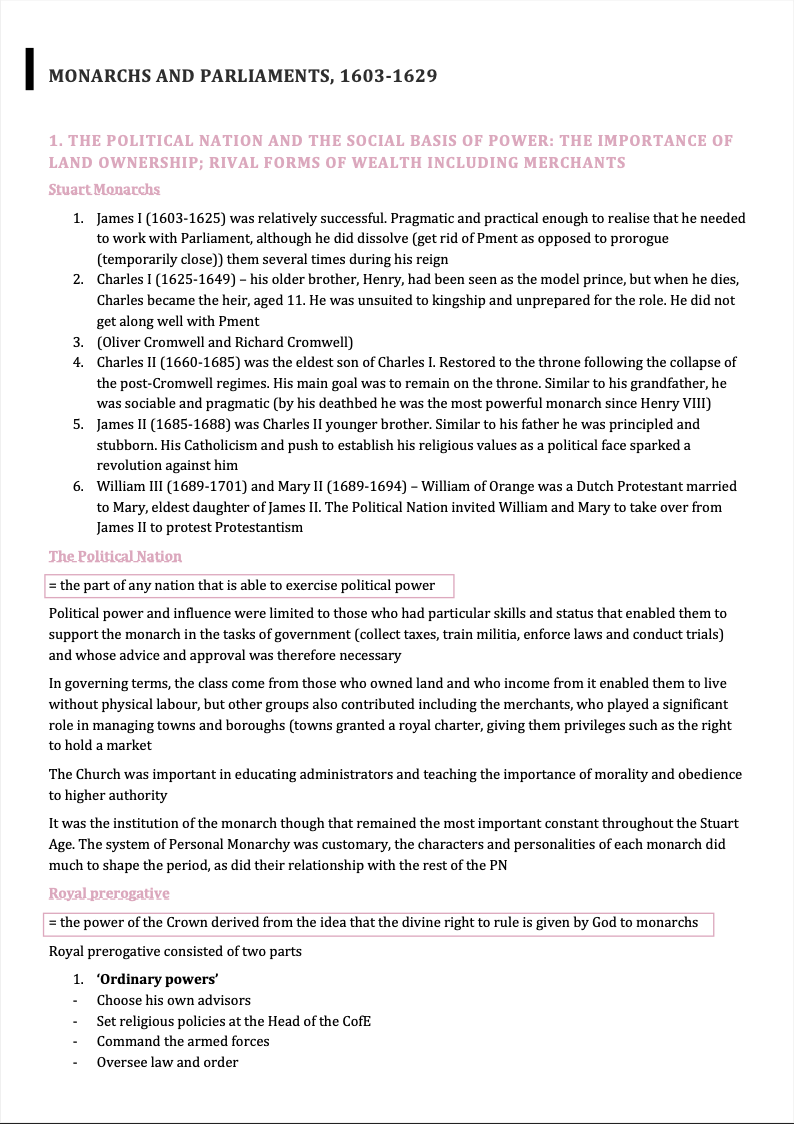Stuarts Revision Guide
A ShareNotes A* Super-Guide.
A ShareNotes A* Super-Guide.
A ShareNotes A* Super-Guide.
The below bullet points are covered in detail across 110+ pages of highly detailed, comprehensive notes. Above product preview is 4 pages of notes on Chapter 1 (The Political Nation and the social basis of power).
Monarchs and Parliaments, 1603–1629
The Political Nation and the social basis of power: the importance of land ownership; rival forms of wealth including merchants
James I: character and views on monarchy; court and favourites; Charles I: character and views on monarchy; court and favourites
The financial weakness of the Crown and attempts to reform and strengthen royal finance
Religion and religious divisions: challenges to the Church of England from Catholics and Puritans and the development of Arminianism
Relations and disputes with parliaments: parliamentary privileges; finance; religion; foreign affairs
The state of relations between Crown and Parliament by 1629 and the reaction of the Political Nation; the extent of breakdown between Crown and Parliament and the Political Nation
Revolution, 1629–1649Divisions over religion: Arminianism and Laudianism; Puritanism and the emergence of Millenarianism
Divisions over religion: Arminianism and Laudianism; Puritanism and the emergence of Millenarianism
Political divisions: the Personal Rule and the extent of opposition to it in England, Scotland and Ireland; the Short and Long Parliaments and the leadership of Pym; divisions and the outbreak of Civil War
The First and Second Civil Wars: England, Scotland, Ireland and the reasons for royalist defeat
Social divisions: the emergence of political and religious radicalism in the 1640s; the Levellers and Millenarian groups
Post-war divisions between Army and Parliament and the failure to secure a post-war settlement
Regicide: the basis for regicide and the King’s response
From Republic to restored and limited monarchy, 1649–1678
The consolidation of the Republic: Scotland and Dunbar; campaigns in Ireland; Charles II and Worcester
Political divisions and experiments: Republicanism and the Rump; Millenarianism and the Parliament of Saints
Cromwell and his aims; the Protectorates; Major-Generals and the relations with the Political Nation
Charles II and the nature of restored monarchy; rule through parliament and ministers; Clarendon; the Cabal and Danby
The emergence of Court and Country ‘parties’: causes, significance and consequences
Religious divisions and conflicts: the defeat of Millenarianism; the restoration of the Church of England; Protestant Dissenters; conflict over Catholic influence at Court
The establishment of constitutional monarchy, 1678–1702
Political developments and conflicts: Exclusion, its aims, methods and its failure; James II and the attempts at absolutism and the restoration of Catholicism
The ‘Glorious Revolution’: causes and nature; its consolidation in England, Scotland and Ireland
Divisions within the Political Nation and the emergence of Whigs and Tories and their impact
Religious changes: religious toleration and changes to the position of Anglicans, Protestants and Catholics
Government under William and Mary: the importance of political parties and ministers; the changing influence of Crown and Parliament and the reasons for the development of limited monarchy
The condition of Britain and its monarchy by 1702: the significance of the Act of Settlement; the balance of power between Crown and Parliament; the condition of the Church of England and non-conformism and Catholicism




